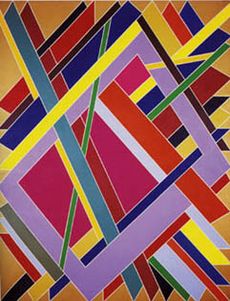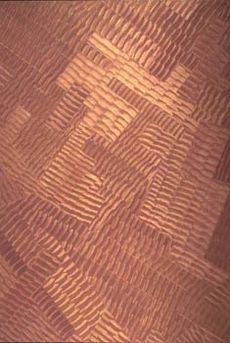William T. Williams facts for kids
Quick facts for kids
William T. Williams
|
|
|---|---|
| Born | July 17, 1942 |
| Alma mater | Pratt Institute, BA, 1966 Yale University, MFA, 1968 |
| Occupation | Visual artist |
| Movement | Abstraction, Black Abstractionism, Geometric abstraction |
William T. Williams (born in 1942) is an American painter and teacher. He is known as one of the most important abstract painters of the last century. His art has been shown in over 100 exhibitions around the world. These include shows in the United States, France, Germany, Japan, and many other countries.
Williams was the first Black painter to be included in a famous art history book called History of Art by H. W. Janson. He is also a key artist in the movement known as Black Abstractionism. From 1971 to 2008, Williams taught art at Brooklyn College, which is part of the City University of New York. He has won many awards, including a Guggenheim Fellowship. Williams lives in both New York City and Connecticut.
Contents
Early Life and Learning
William Thomas Williams was born on July 17, 1942, in Cross Creek, North Carolina, USA. His parents were William Thomas Williams Sr. and Hazel Williams. His family moved to Queens, New York, when he was four years old. He spent his summer breaks in Spring Lake, North Carolina.
When he was young, a community center leader noticed his art talent. This person gave him a room to use as his own art studio. In 1956, he went to the School of Industrial Art in Manhattan. This school is now called the High School of Art and Design. Many of its art classes were held at famous places like the Museum of Modern Art and the Metropolitan Museum of Art.
After high school, Williams studied at New York Community College City Tech. He earned a special degree there in 1962.
College and Art School
Williams then went to Pratt Institute to continue his art studies. He took painting classes with well-known artists like Richard Lindner and Alex Katz. During his third year, he won a summer scholarship to The Skowhegan School of Art. He also received a travel grant from the National Endowment for the Arts. While in school, he explored a style called color field painting. This style uses large areas of flat color. He earned his Bachelor of Fine Arts (BFA) degree from Pratt Institute in 1966.
After Pratt, Williams attended Yale School of Art. He earned his Master of Fine Arts (MFA) degree there in 1968. While at Yale, Williams had an important idea. He thought of a program where artists could live and work in a community, connected to an art museum. This idea helped start The Studio Museum in Harlem's artist-in-residence program. This program is still very popular today. It brings artists from all over the world to work in different art forms.
Art in the 1960s and 1970s
From 1968 to 1970, Williams helped create the Smokehouse Associates. This was a group of artists who painted murals in Harlem. They painted in both usual and unusual places.
Williams quickly became noticed in the art world. The Museum of Modern Art bought his painting "Elbert Jackson L.A.M.F., Part II" in 1969. By 1970, his art was shown in France at the Fondation Maeght.
In 1969, he took part in a discussion called The Black Artist in America: A Symposium. This event was held at the Metropolitan Museum of Art. He also showed his work in many exhibitions. These included the first show at the Studio Museum in Harlem and new art shows at the Museum of Modern Art. In 1970, the Jewish Museum (New York) and the Menil Collection in Houston, Texas, asked him to create art for them.
First Solo Show and New Inspiration
Williams had his first solo art show in New York in 1971. Every painting in the show was sold! In the same year, the Whitney Museum of American Art showed his work twice. Big companies like AT&T and General Mills bought his art. His work was also featured in famous magazines like Life and Time.
Williams went back to North Carolina for new ideas. He found inspiration in the natural colors and glow of the earth there. This led to new works between 1971 and 1977, like "Equinox" and "Indian Summer." In 1975, he also worked as an artist-in-residence at Fisk University in Nashville, Tennessee.
In 1977, Williams took part in the second World Festival of Black Arts and African Culture. This huge festival was held in Lagos, Nigeria. Over 17,000 artists from 59 countries came together. It was the largest cultural event ever held in Africa.
Starting in 1979, Williams changed his painting style. He began dividing his canvases into two clear sections.
Art in the 1980s
In 1982, Williams's art was added to the Schomburg Collection in New York. In 1984, he was part of a traveling show called Since the Harlem Renaissance. This show visited many universities and museums across the United States.
From 1984 to 1985, Williams was a visiting art professor at Virginia Commonwealth University.
In 1985, he had a solo exhibition at the Southeastern Center for Contemporary Art in North Carolina.
In 1986, Williams became the first Black modern artist to be included in a well-known art history textbook. This book was H.W. Janson’s The History of Art.
In 1987, William received the John Simon Guggenheim Fellowship. He also took part in an art show in Tokyo, Japan, called The Art of Black America in Japan. Williams also showed his work in Contemporary Visual Expressions at the Anacostia Museum and Smithsonian Institution in Washington, D.C.
Williams traveled to Venezuela with other artists for an exhibition. Their show was called Espiritu & Materia at the Museum of Visual Arts, Alejandro Otero.
Art in the 1990s
In 1992, Williams received the Studio Museum in Harlem Artist's Award. This award honored his lifetime achievements and his role in starting the museum's artist-in-residence program. Williams also worked with artist Robert Blackburn for many years. Together, they created many unique prints.
In 1994, Williams joined a program called "Swing Landscapes: Jazz Visualized" at Jazz at Lincoln Center. This program explored how jazz music influences visual art. Williams and an author discussed how jazz affected modern art. This event was part of a city-wide celebration for the artist Romare Bearden.
Art in the 2000s
In 2000, Williams was part of a large traveling exhibition. It was called To Conserve a Legacy: American Art from Historically Black Colleges and Universities. The show visited eight major museums, including the Art Institute of Chicago and the Corcoran Gallery of Art.
In 2005, Williams was asked to create a print at the Brandywine Workshop. This was when he received the James Van Der Zee Award for Lifetime Achievement. He made several trips to Philadelphia and created many unique prints there. The Brandywine Workshop helps promote printmaking and cultural diversity in art.
In 2006, Williams was a visiting scholar and artist at Lafayette College. He gave a lecture about his work there. In the same year, his art was shown at the Studio Museum in Harlem. This exhibition was called Energy and Experimentation: Black Artists and Abstraction 1964–1980.
Also in 2006, William T. Williams received the North Carolina Governors Award for Fine Arts. This award was given by Governor Mike Easley.
In 2007, Williams was part of a group show at the Museum of Modern Art in New York City. The exhibition was called What Is Painting? Contemporary Art from the Collection.
Art in the 2010s and 2020s
In 2016, Williams's art was featured in the first exhibition at the Smithsonian Institution's National Museum of African American History and Culture. This show was called Visual Art and The American Experience.
In 2017, his work was included in a very important exhibition. It was called Soul of a Nation: Art in the Age of Black Power. This show started at Tate Modern in London and traveled to six major museums across the United States until 2020.
In 2024, Williams was part of a group exhibition at The Metropolitan Museum of Art. The show was called Flight into Egypt: Black Artists and Ancient Egypt, 1876–Now. It was on display until February 2025.
Art Collections
Williams's art can be found in over thirty museum collections. Some of these include:
- The Museum of Modern Art
- The Whitney Museum of American Art
- The National Gallery of Art
- The Studio Museum in Harlem
- The Library of Congress
- The National Museum of African American History and Culture
- The Philadelphia Museum of Art
- The Yale University Art Gallery
Awards and Honors
- Murray Reich Distinguished Artist Award, New York Foundation for the Arts, 2024
- Lifetime Achievement Award, James A. Porter Colloquium on African American Art, Howard University, 2019
- Pratt Institute Legends Award, 2018
- Skowhegan Governors Award for Outstanding Service to Artists, 2017
- Inducted into the National Academy Museum & School, 2017
- Alain Locke International Award, Detroit Institute of Arts, 2011
- North Carolina Governor's Award for Fine Arts, 2006
- James Van Der Zee Award, Brandywine Workshop, 2005
- Joan Mitchell Foundation, Grant Award, 1996
- National Endowment for the Arts, Individual Artist Award, Painting, 1994
- The Studio Museum in Harlem Artist's Award, 1992
- John Simon Guggenheim Fellowship, 1987
- Creative Arts Public Service Grant, Painting, New York, 1985, 1981, 1975
- National Endowment for the Arts, Individual Artist Award, Painting, 1970



